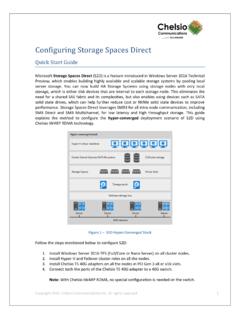Transcription of High-Performance Networking for Optimized Hadoop …
1 WHITE PAPER. High-Performance Networking for Optimized Hadoop Deployments Chelsio Terminator 4 (T4) Unified Wire adapters deliver a range of performance gains for Hadoop by bringing the Hadoop cluster Networking into optimum balance with the recent improvements in server and storage performance , while minimizing the impact of high- speed Networking on the server CPU. The result is improved Hadoop Distributed File System (HDFS) performance and reduced job execution times. Executive Summary Typical Hadoop scale-out cluster servers utilize TCP/IP Networking over one or more Gigabit Ethernet network interface cards (NICs) connected to a Gigabit Ethernet network.
2 However, the latest genera tion of commodity servers offers multi-socket, multicore CPU technology like Intel's Nehalem, which outstrips the network capacity offered by GbE networks. With advances in processor technology, this mismatch between server and network performance is predi cted to grow. Similarly, while Solid State Disks (SSDs) are evolving to offer equivalent capacity-per-dollar of Hard Disk Drives (HDDs), they are also being rapidly adopted for caching and for use with medium -sized datasets. The advances in storage I/O. performance offered by SSDs exceeds the performance offered by GbE Networking , which makes network I/O increasingly the most common impediment to improved Hadoop cluster performance .
3 10 Gigabit Ethernet has the potential of bringing the Hadoop cluster netwo rking into balance with the recent improvements in performance brought by server CPUs and advances in storage technology. Balancing the performance of server network I/O improves the efficiency of every server in the cluster, thus improving the performance of the entire Hadoop infrastructure by removing critical bottlenecks. However, to achieve optimum balance, the network I/O gains delivered by 10 GbE must come with optimal efficiency so that the impact of high-speed network I/O on the server CPU is minimized.
4 The Chelsio T420 10 GbE Unified Wired Adapter utilizes Chelsio's Terminator 4 (T4), a highly integrated 10 GbE ASIC chip built around a programmable protocol processing engine. The T4 ASIC represents Chelsio's fourth generation TCP offload engine (TOE) design and second generation iWARP (RDMA). implementation. The T4 demonstrates better performance across a range of benchmarks than that for Terminator 3 (T3), while running the same microcode that has been field -proven in very large clusters. Chelsio's 10 GbE adapters improve network performance by leveraging an embedded TOE, which offloads TCP/IP stack processing to the server NIC.
5 Used primarily with high -speed interfaces such as WHITE PAPER. 10 GbE, the TOE frees up memory bandwidth and valuable CPU cycles on the se rver, delivering the high throughput and low latency needed for cluster Networking applications, while leveraging Ethernet's ubiquity, scalability, and cost-effectiveness. Chelsio 10 GbE TOE is aimed at increasing the ability to move data into and out of a server in multi-core processing server environments and has proven to be ideal for environments where servers are concurrently required to run CPU as well as network I/O-intensive tasks such as Hadoop cluster Networking .
6 A key benefit of the Chelsio 10 GbE TOE implementation is that it maintains full socket streaming semantics enabling applications, such as HDFS, using the sockets programming model to leverage its performance capabilities without modification. The Chelsio T4 second generation iWARP design builds on the RDMA capabilities of T3 while leveraging the embedded TOE capabilities, with advanced techniques to reduce CPU overhead, memory bandwidth utilization, and latency by combining offloading of TCP/IP processing from the CPU, eliminating unnecessary buffering, and dramatically reducing expensive operating system calls and context switches thereby moving data management and network protocol processing to the T420 10 GbE Unified Wire Adapter.
7 The OpenFabrics software stack that is fully integrated into the flavors of Linux distributed by Novell and Red Hat fully supports 10 GbE iWARP. Independent benchmarking has determined a whole range of performance advantages of Chelsio 10 GbE. solutions compared to GbE for Hadoop cluster environments. Chelsio 1 0 GbE adapters were found to lead to network and storage I/O balance in Hadoop cluster nodes and while clearly complementing the use of SSDs in dramatically improving HDFS sequential and random write performance , and reducing job execution times.
8 2. WHITE PAPER. Introduction -- The Big Data Imperative The growing number of people, devices, and sensors that are now interconnected by digital networks has revolutionized our ability to generate, communicate, share and access data. In 2010, more than four billion people (or 60 percent of the world's population) were connected by cell phones and 12 percent of those were using smart phones, whose market penetration was growing at 12 percent per year. Today, more than 30 million networked sensors are deployed in the t ransportation, automotive, utilities, and retail sectors.
9 The number of sensors is increasing at a rate of 30 percent per year. This has created a large data management problem, which is now referred to as The Big Data Imperative.. Big Data refers to datasets whose size is beyond the ability of typical database software tools to capture, store, manage, and analyze. As technology advances over time, the size of data sets that qualify as big data will also increase. The definition will also depend on the sizes of datasets common in a particular industry and the types of software tools available. Hadoop is being widely accepted as a solution to the problem.
10 The Apache Hadoop open source software addresses the problems associated with big data in two key ways. First, it provides a highly scalable distributed file system, called the Hadoop Distributed File System (HDFS), which is used for storing, managing, and securing very large datasets. Second, the Hadoop MapReduce framework provides a powerful programming model capable of harnessing the computing power of several commodity servers into a single High-Performance computing cluster capable of efficiently analyzing large datasets. Hadoop Overview and Benefits Hadoop is a powerful, fault-tolerant platform for managing, accessing, and analyzing very large datasets.


